Invented by Dan H. Barouch, Bette T. Korber, William M. Fischer, Beth Israel Deaconess Medical Center Inc, Triad National Security LLC
Cellular immunogenicity refers to the ability of the immune system to recognize and respond to viral antigens at the cellular level. Antiviral vaccines that improve cellular immunogenicity are designed to enhance the ability of the immune system to recognize and respond to viral antigens. These vaccines are typically based on live attenuated or inactivated viruses, viral vectors, or subunit vaccines.
Live attenuated vaccines are made from weakened viruses that are still able to replicate in the body but are less virulent than the original virus. These vaccines stimulate a strong immune response and provide long-lasting immunity. Inactivated vaccines are made from viruses that have been killed or inactivated, and they stimulate a weaker immune response than live attenuated vaccines. Viral vector vaccines use a harmless virus to deliver viral antigens to the immune system, while subunit vaccines contain only specific viral antigens.
The market for antiviral vaccines that improve cellular immunogenicity is driven by the increasing prevalence of viral diseases such as influenza, hepatitis, and human papillomavirus (HPV). These diseases can cause serious health problems and even death, and there is a growing need for effective vaccines to prevent them.
The global market for antiviral vaccines is expected to grow at a compound annual growth rate (CAGR) of 6.5% from 2021 to 2028, reaching a value of $9.4 billion by 2028. The market is driven by the increasing demand for vaccines against viral diseases, the development of new technologies for vaccine production, and the growing awareness of the importance of vaccination.
North America is the largest market for antiviral vaccines, followed by Europe and Asia-Pacific. The United States is the largest market in North America, accounting for over 80% of the market share. The market in Asia-Pacific is expected to grow at the highest CAGR during the forecast period, driven by the increasing prevalence of viral diseases and the growing demand for vaccines in emerging economies such as China and India.
The major players in the market for antiviral vaccines that improve cellular immunogenicity include GlaxoSmithKline plc, Merck & Co., Inc., Sanofi Pasteur SA, Pfizer Inc., and Novartis AG. These companies are investing heavily in research and development to develop new and improved vaccines against viral diseases.
In conclusion, the market for antiviral vaccines that improve cellular immunogenicity is growing rapidly due to the increasing demand for effective vaccines against viral diseases. The market is driven by the development of new technologies for vaccine production, the growing awareness of the importance of vaccination, and the increasing prevalence of viral diseases. The major players in the market are investing heavily in research and development to develop new and improved vaccines, and the market is expected to continue to grow in the coming years.
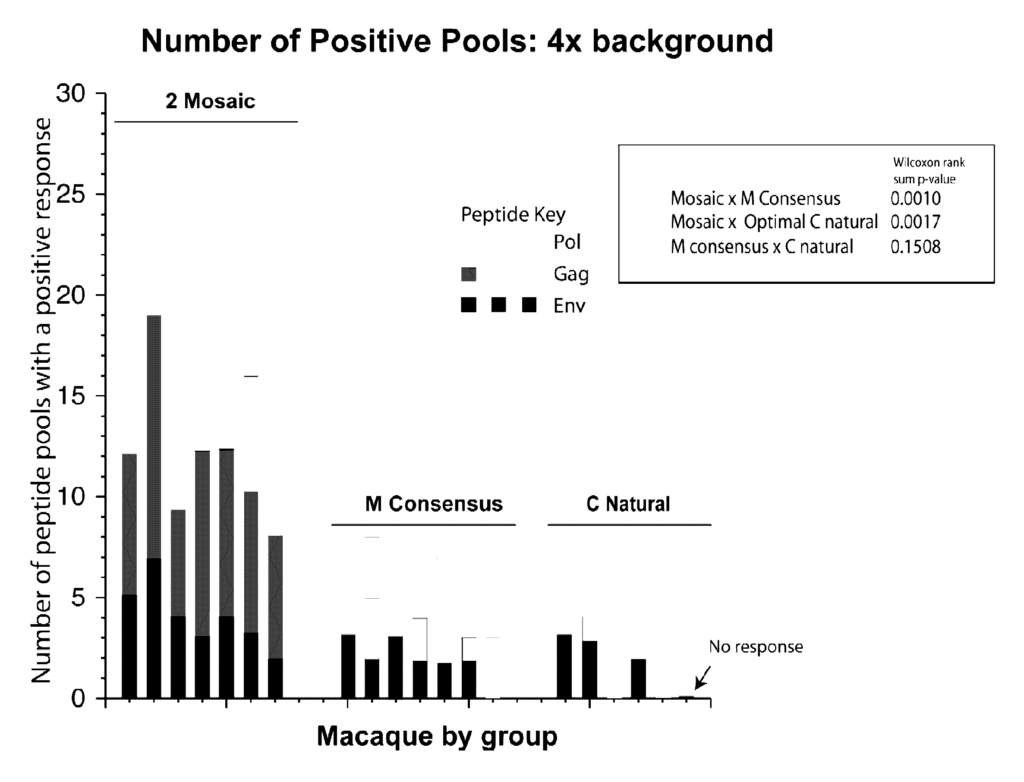
The Beth Israel Deaconess Medical Center Inc, Triad National Security LLC invention works as follows
The invention provides compositions and methods for the treatment or prevention viral infections.” The polyvalent (e.g., 2-valent) vaccines described herein incorporate computationally-optimized viral polypeptides that can increase the diversity or breadth and depth of cellular immune response in vaccinated subjects.
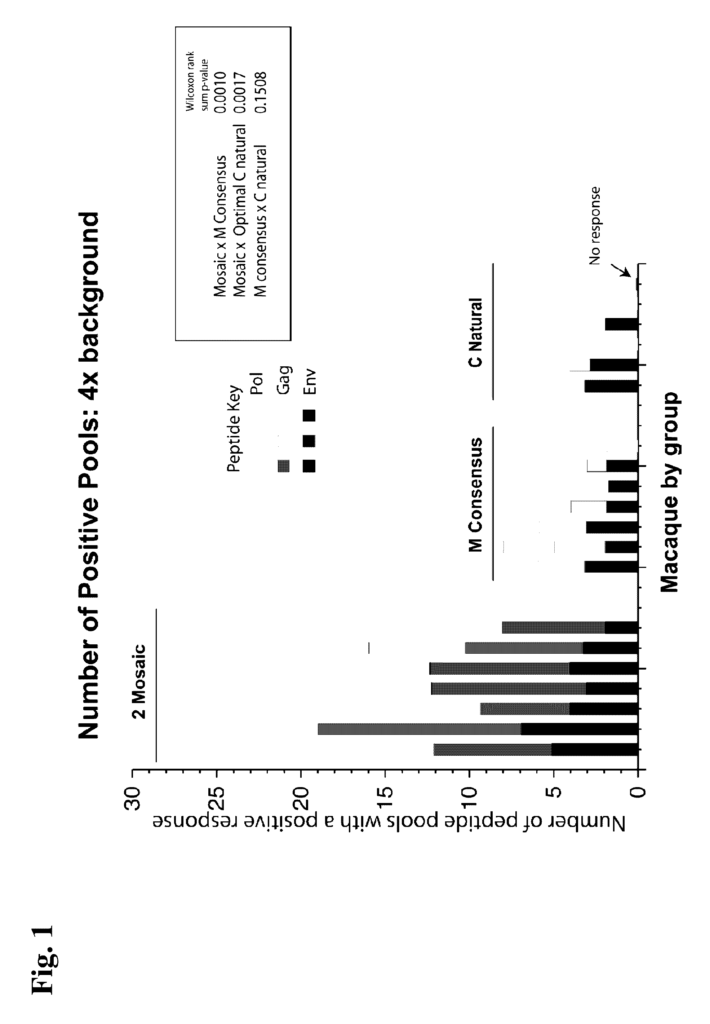
Background for Antiviral vaccines that improve cellular immunegenicity
To be effective in preventing or treating viral infection, vaccines must elicit immune responses from cells against viruses. An effective HIV-1 vaccine will likely require the induction of diverse and intense HIV-1-specific T cells responses. The slow progression of HIV-1 disease in humans is correlated with cytotoxic T lymphocyte (CTL), responses. It is well-established that CTL responses are important in non-human primates vaccination models. Although the Envelope (highly variable HIV-1 protein) is the main target for neutralizing antibodies, vaccine antigens must also be tailored to induce these antibody responses. T cell vaccine components can target conserved proteins to trigger reactions that are more likely cross-react. Variation will still be a problem for even the most well-known HIV-1 proteins. Artificial central-sequence vaccines, such as the consensus and ancestral HIV-1 sequences can essentially “split” the differences. Cross-reactivity between strains can be enhanced compared to natural strain vaccinations. The consensus antigens are synthetic antigen sequences that have the best overall?average?. There are many circulating strains. These antigens may elicit cellular immune responses that can be directed, but they are not significantly more effective than previous vaccine strategies. To ensure successful vaccination, next-generation vaccines that treat or prevent viral infections must generate a greater level of cellular immunity. These vaccines are especially urgent in the fight against HIV-1.
In the first aspect of the invention is a vaccine that treats or reduces the risk of viral infection in mammal such as human. The vaccine includes at least two distinct optimized virus polypeptides. These optimized viral polypeptides may correspond to the same viral product. One embodiment of the virus causes infection by retroviruses, picornaviruses, togaviruses, orthomyxoviruses, paramyxoviruses, calicivirus and flavivirus. Another aspect involves a vaccine for treating or reducing the risk of a viral infection in a mammal such as a human. This vaccine includes astroviruses, adenoviruses, papillomaviruses, parvovirusesvirusesvirusesvirusesvirusesvirusesvirusesvirusesvirusesvirusesvirusevirusesvirusesvirusesvirusesvirusesvirusesvirusesvirusesvirusesviruse, poxvirusesvirusesvirus, poxvirusesvirusesvirus, poxvirusesvirusesvirusesvirusesvirus. Other embodiments use retrovirus as human immunodeficiency viruses type 1 (HIV-1), with the viral gene products being Gag, Pol Env, Tat, Rev and Vif, Pr, or Vpu. A further embodiment of the vaccine contains no more than two optimized virus polypeptides that correspond to one of the Gag or Pol, Env and Nef viral gene products. Another embodiment of the vaccine excludes optimized viral polypeptides that correspond to Gag or Nef. Another embodiment of the vaccine contains at least two optimized viral proteins (e.g. 2, 3, 4, 5 or more distinct optimized virus polypeptides for a first viral product selected from Gag or Pol or Env or Nef or Tat, Rev and Vif/Vpr and Vpu) and one or more optimized viral protein peptides for a second viral product (e.g. 2, 3, 4, 5 or more distinct optimized virus polypeptides for a second viral product other than the first viral product selected from Rev, Rev, Vif/Vpr and Vif, Vpr and Vpr and Vpr and Vpr and Vpr and Vpr and Vpr and Vpr and Vif, Vpr and Rev, Vpr and Vpr and Vpu
In a second embodiment, the invention includes a vaccine to treat or reduce the risk of human immune deficiency virus type 1 infection in a mammal such as a human. It comprises an optimized viral polypeptide having at least seven contiguous amino acids (e.g. at least 8, 9, 10, 12, 13, 14, 15, 16, 17-18, 19, 20, 22, 23, 24, 26, 27, 28, 29, 30, 50. 100, 150. 175, 200. 250. 350. 400. 450. 500 or more contiguous in length). One embodiment of the optimized viral polypeptide includes at least seven contiguous amino acids (e.g. 8, 9, 10, 11, 12, 13, 15, 16, 17, 18, 19, 25, 26, 27, 28, 29, 29, 30, 50, 100. 150. 175, 200. 250. 350. 400. 450. 500 or more contiguous amino acids in length). It also has amino acid sequence identity to any sequence in SEQ ID NoS:1-29. Another embodiment of the optimized viral protein has the same amino acid sequence as any of the sequences in SEQ ID NOS:1-29. A further embodiment of the vaccine contains at least two optimized virus polypeptides. These can be from any one of the following groups: a. SEQID NOS.1 and 2, b. SEQID NOS.3, 4, or 5, c. SEQID NOS.6 and 7, d. SEQID NOS.8-12, e. SEQID NOS.13, 14 and 15, c. SEQID NOS.16, 17, and 18, g. SEQID NOS.26 and 27, k; k). Another embodiment of the vaccine may include two optimized viral proteins from one of the groups a-k; b) SEQ ID NOS:1, 2, and 4; c) SEQ ID NOS:6 and 7; d) SEQ ID NOS:8-12; e) SEQID NoS 13-14, 15 or 16 or 17 or 18 or 20; h) SEQID noS 24 or 25; j) SEQID NOS 26 or 27. k) and sEQIDNOS:21-22 Other embodiments allow the vaccine to include at least three, four, or more optimized virus polypeptides from any one of the groups a(-k).
A third aspect of the invention consists of a vaccine that treats or reduces the risk of viral infection in mammals, such as humans, that contains at least two distinct optimized viral peptides. Each pair corresponds to the exact same viral gene products and no more than two vaccines contain the same optimized viral peptides. One embodiment of the vaccine contains at least three distinct optimized viral polypeptides. Another embodiment includes at least four distinct optimized viral polypeptides. One embodiment of the virus infection is caused either by a retrovirus or picornavirus. Other embodiments use retrovirus as human immunodeficiency viruses type 1 (HIV-1), with the viral gene products being Gag, Pol Env, Tat, Rev and Vif, Pr, or Vpu. A further embodiment of the vaccine contains no more than two optimized virus polypeptides that correspond to one of the Gag or Pol, Env and Nef viral gene products. Another embodiment of the vaccine excludes optimized viral polypeptides that correspond to Gag or Nef. A further embodiment of the vaccine contains at least three distinct optimized viral polypeptides that correspond to any three of the Gag or Env, Tat, Rev and Vif, Vpr viral gene products. Another embodiment of the vaccine contains at least four distinct optimized viral polypeptides that correspond to any four of the Gag or Pol, Env and Nef, Tats, Rev, Vif. Vpr or Vpu viral genes products.
In one embodiment, any of the three first aspects of the invention, vaccine elicits an immune response in the cells against a virus gene product. Another embodiment of the vaccine triggers a cellular immune reaction against HIV-1. A further embodiment encodes the nucleotide sequence for at least one distinct optimized virus polypeptide using a nucleic acids or vector. One embodiment of the vector is a recombinant virus, such as Adenovirus Serotype 26 (Ad26), Adenovirus Serotype 34, (Ad34), Adenovirus Serotype 35, (Ad35), or Adenovirus Serotype 48 (Ad48), and adenovirus Serotype 5 (Ad5HVR48). A further embodiment of the vaccine includes a pharmaceutically acceptable carrier or excipient.
In a fourth aspect, the invention includes a nucleic acids that include the nucleotide sequence for an optimized viral polypeptide. This means that the invention has at least 100, 150 and 175, 200, 250. 350. 400. 450. 500, or more contiguous amino acids in its length. It also has at least 85% sequence identity to any of the amino acid sequences in SEQ ID NoS:1-29. One embodiment of the optimized viral polypeptide contains at least seven contiguous amino acids (e.g. 8, 9, 10, 11, 12, 13, 15, 16, 17, 18, 19, 25, 26, 27, 28, 29, 29, 30, 50. 100, 150. 175, 200. 250. 350. 400. 450. 500 or more contiguous amino acids in length). This amino acid sequence identity is to any of the SEQ ID NOS.1-29. Another embodiment of the optimized viral protein contains any one of the following amino acid sequences: SEQ ID NOS 229 A further embodiment of the nucleic acids includes a vector. One embodiment of the vector includes a recombinant virus, such as Adenovirus Serotype 26 (Ad26), Adenovirus Serotype 34 (Ad34), Adenovirus Serotype 35 (Ad35), Adenovirus Serotype 48 (Ad48), and/or Adenovirus Serum 5 HVR48, (Ad5HVR48).
In a fifth embodiment, the invention includes an optimized viral polypeptide having at least seven contiguous amino acids (e.g. at least 8, 9, 10, 12, 13, 14, 15, 16, 17-18, 19, 20, 22, 23, 24, 25, 27, 28, 29, 30, 50. 100, 150, 175, 200. 250, 350, 400. 450, 500, or more contiguous amino acids in length) with at least 85% sequence identity to any of the amino acids set forth in SEQID NOS:1-29. One embodiment of the optimized viral polypeptide contains at least seven contiguous amino acids (e.g. 8, 9, 10, 11, 13, 14, 15, 16, 17, 18, 19, 25, 26, 27, 28, 29, 29, 30, 50, 100. 150. 175, 200. 250. 350. 400. 450. 500 or more contiguous amino acids in length). It has sequence identity to any of the amino acids set forth in SEQID NOS:1-29. Another embodiment of the optimized viral protein includes any of the following amino acid sequences: SEQ ID NOS.1-29.
In a sixth aspect of the invention, a method is described for treating or reducing the risk from a viral infection in a mammal such as a human by administering a vaccine, nucleic acid, or other treatment. One embodiment of the virus is a retrovirus. Further embodiments of the retrovirus include human immunodeficiency viruses type 1 (HIV-1), Gag, Pol and Env, Tat, Rev. Vif, Vpr. or Vpu. One embodiment of the vaccine or nucleic acids elicits a cell immune response against a virus gene product.
In a seventh embodiment, the invention describes a method for manufacturing a vaccine to treat or reduce the risk of a virus infection in a mammal such as a human. The invention synthesizes a vaccine.
In the eighth aspect of the invention, the invention describes a method for manufacturing a vaccine to treat or reduce the risk of a virus infection in a mammal such as a human. This is done by contacting a nucleic Acid of the invention with a cell, and isolating an optimized viral polypeptide.
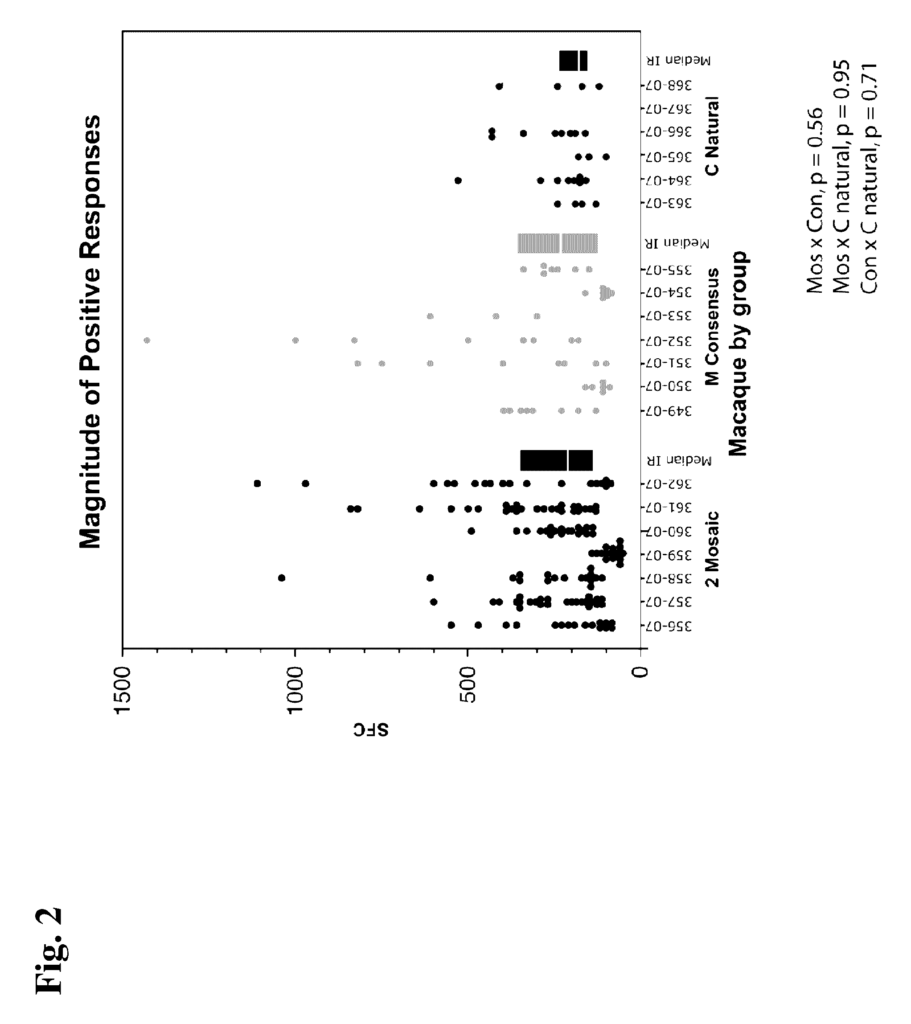
In one embodiment, the seventh or eighth aspect of the invention, an optimized viral polypeptide induces a cellular immune reaction when administered to a mammal. A viral gene product can also trigger a cellular immune response. Another embodiment of the virus infection is caused either by a retrovirus or picomavirus. Further embodiments include the retrovirus as human immunodeficiency viruses type 1 (HIV-1), with the viral gene products being Gag, Pol and Env, Tat, Rev., Vpr. or Vpu.
In a ninth embodiment, the invention includes a kit that contains a vaccine of invention, a pharmaceutically acceptable carrier or excipient, as well as instructions for its use. The kit may also include an adjuvant in one embodiment.
In a final embodiment, the invention includes a kit that contains a nucleic Acid of the invention, a pharmaceutically accepted carrier, excipient or diluent and instructions for its use. The kit may also include an adjuvant in one embodiment.
In an embodiment that incorporates all aspects of the invention, a viral polypeptide optimized for expression in humans is encoded by a sequence of nucleic acids (e.g. any one of SEQ ID NoS:5, 10, 11, 12, 15, 18, or 23).
DEFINITIONS
By?optimized virus polypeptide?” or ?computationally-optimized viral polypeptide? An immunogenic polypeptide is one that is not naturally occurring viral peptides, polypeptides, or proteins. Initially, optimized viral polypeptide sequences can be created by altering the amino acid sequences of one or more naturally occurring viral gene products (e.g. peptides or proteins) in order to increase the breadth and intensity of the antiviral immune reaction (e.g. cellular or humoral immunity responses) that is generated upon immunization of a mammal (e.g. when incorporated into vaccine of the invention). The optimized viral polypeptide could be a?parent? The optimized viral polypeptide might not match a specific ‘parent’ sequence. The sequence of the viral gene may be identical to sequences from other strains or quasi-species. Amino acid additions, substitutions and deletions can all be made to the viral sequence. One embodiment of the invention describes the optimized viral peptide as a composite or merged sequence of amino acids from two or more naturally occurring viral gene products. To facilitate incorporation of the invention’s vaccine, optimized viral polypeptides can be fused with different viral genes. Fisher et. al. describe methods for generating optimized viral polypeptides. “Polyvalent Vaccine to Optimal Coverage for Potential T-Cell Epitopes In Global HIV-1 Variants,” Nat. Med. 13(1):100-106 (2006) and International Patent Application Publication (WO 2007/024941), herein incorporated as reference. The optimized viral polypeptide sequence can be generated once the polypeptide is prepared.
By a?pharmaceutically acceptable transporter? A carrier that is physiologically acceptable for the treatment mammal and retains the therapeutic properties of its compound. The physiological saline is an example of a pharmaceutically acceptable carrier. Others physiologically acceptable carriers are also known and can be found in the art. These formulations can be described in Remington’s Pharmaceutical Sciences (18th Edition, ed. A. Gennaro 1990, Mack Publishing Company Easton, Pa., incorporated herein as a reference
By ?vector? “Vector” refers to a DNA construct that is operably linked with a downstream gene (e.g., a genomic DNA fragment or cDNA, which encodes a protein or polypeptide fragment) The vector can be introduced into a recipient cell (e.g. a prokaryotic, eukaryotic, mammalian, or insect cell depending on the promoter in the expression vector). This allows the cell or organism to express the mRNA encoded within the vector. This is then translated into an optimized viral polypeptide according to the invention. Vectors for in vitro transcription/translation are also well known in the art and are described further herein. A vector can be any genetically engineered virus, plasmid or artificial chromosome, which is derived from, for example, a bacteriophage or retrovirus, poxvirus or herpesvirus.
By ?viral gene product? Any naturally occurring viral peptide or polypeptide, protein or fragment is considered to be a viral gene product. One embodiment of the invention reveals that the viral gene product is derived form the human immunodeficiency viruses type 1 (HIV-1). HIV-1 viral products include the Env, Tat, Tat, Tat, Rev and Vif polypeptides.
The invention contains optimized viral polypeptides, which are computationally derived naturally-occurring virus gene products. After immunization with one or more of the optimized viral peptides, or vaccines (e.g. a vector), a subject (e.g. a human) is given one or more of the optimized viral peptides. The invention allows for vaccines to be administered to any subject (e.g., human) that is infected or at risk of becoming infected by a virus infection. The invention provides vaccines that contain at least two optimized viral polypeptides per corresponding viral gene products. Incorporating at least two different optimized viral polypeptides for each corresponding virus gene product allows for greater coverage and representation of immunogenic epitopes. The inventors found that this results in an increase of the number of virus-specific immune reactions after vaccination. The invention also includes methods for administering and manufacturing vaccines and vectors as well as optimized viral polypeptides. By providing at least two different optimized viral polypeptides, the compositions, methods and kits described herein, the range of virus-specific cell immune responses can be significantly increased.
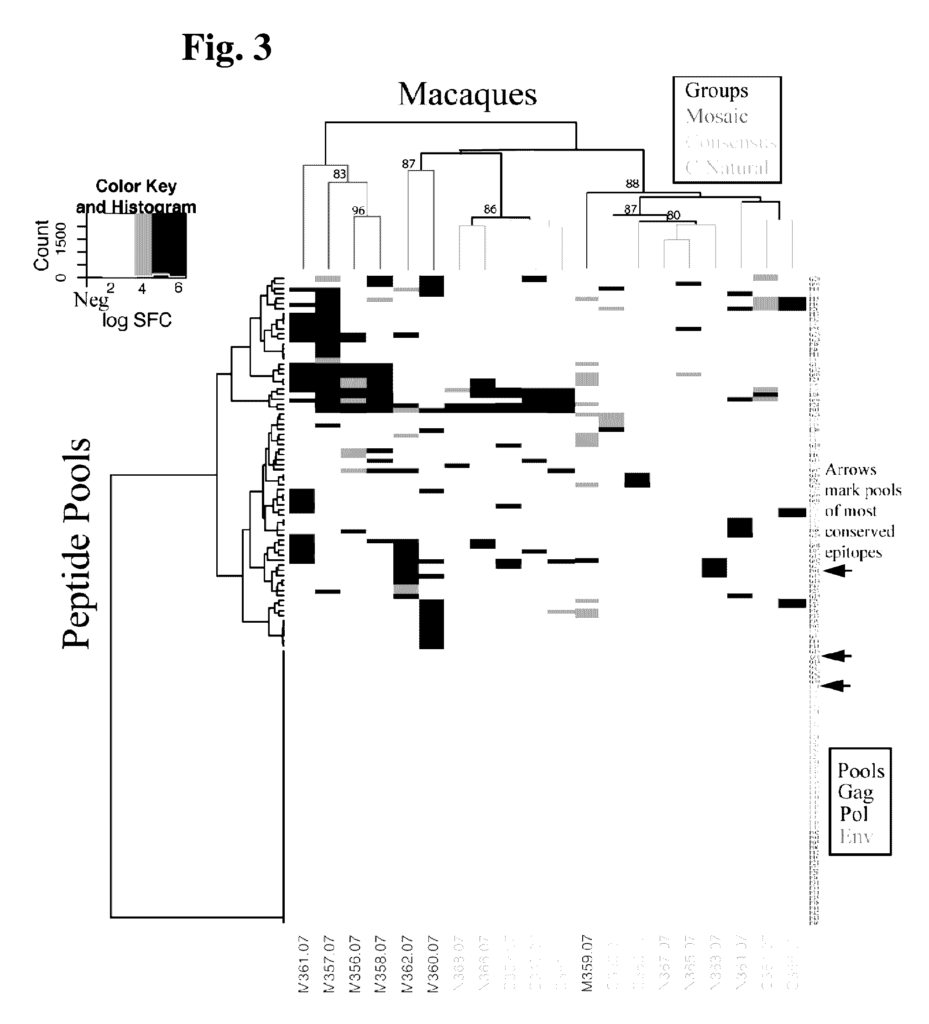
Optimized Viral Polypeptides from the Invention
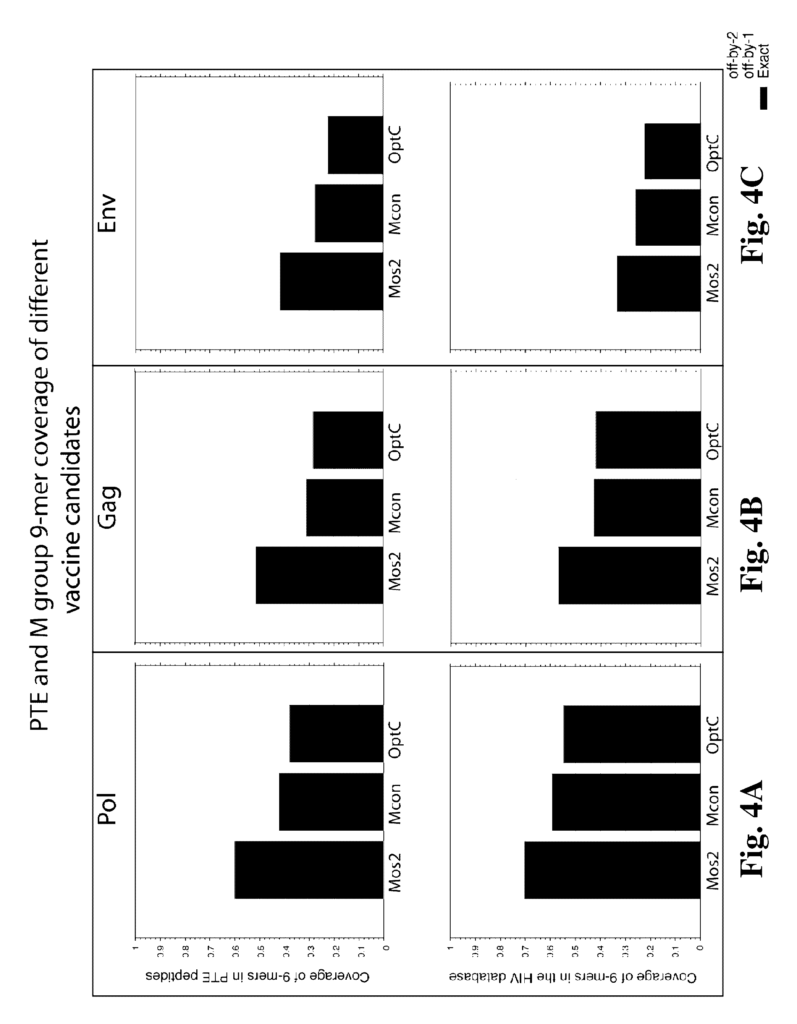
Click here to view the patent on Google Patents.
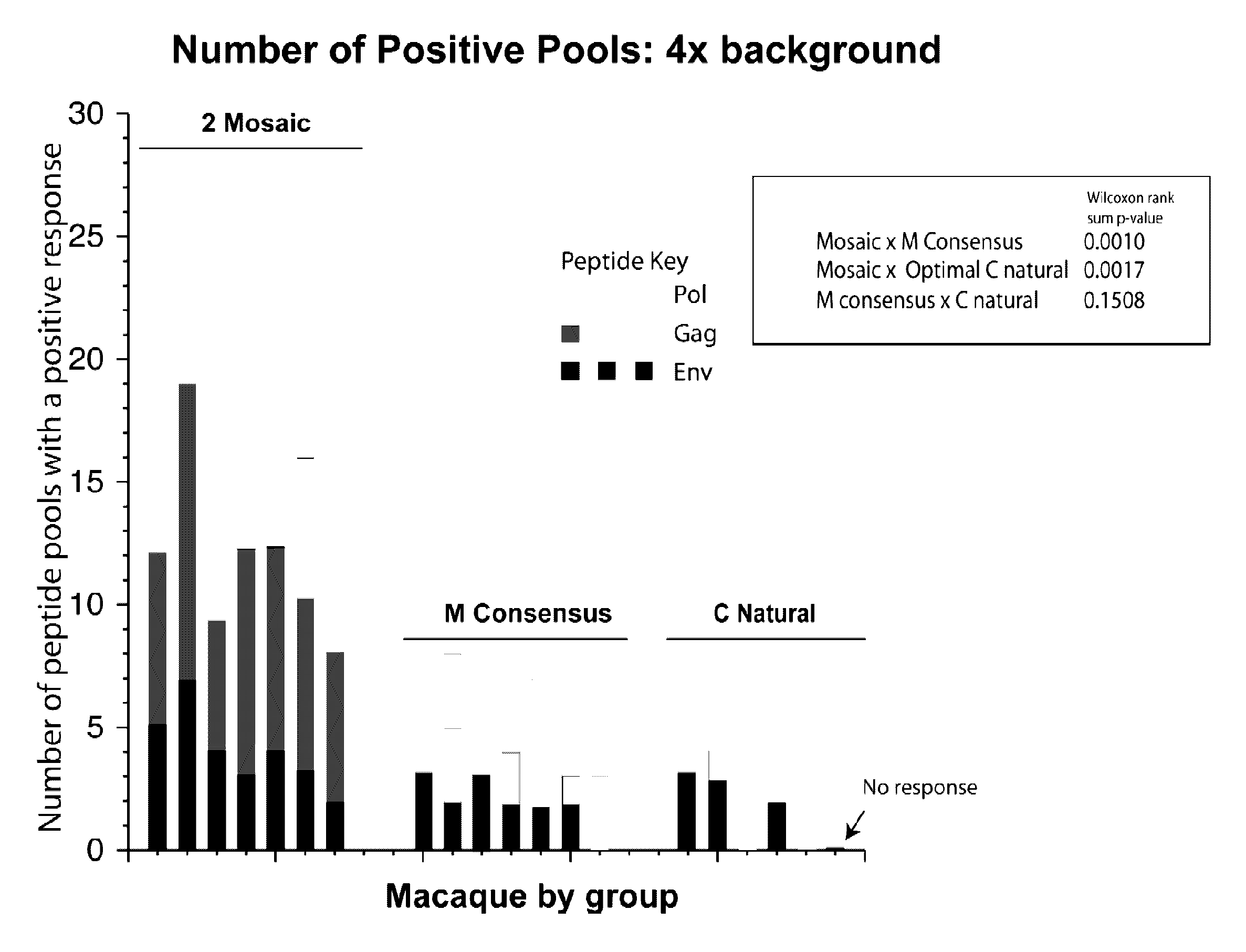
Leave a Reply